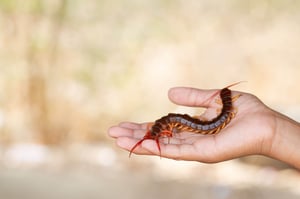 What Is the Texas Redheaded Centipede?
What Is the Texas Redheaded Centipede?
When you live in Texas, you can expect to interact with a few critters such as scorpions, spiders and even snakes. However, nothing will prepare you for the gigantic centipedes found there. Scolopendra Heros, also known as the Texas redhead centipede or the Giant desert centipede, is a Northern American Centipede located in northern Mexico and the southern United States, in Arkansas, Arizona, Missouri and Louisiana.
General Appearance
The Texas redhead centipede is large, measuring around 6.5 inches (17 centimeters) but can grow up to 8 inches (20 centimeters). It has around 20 to 21 pairs of legs and appears dark-brown with a redhead. The color is useful in scaring off prey and works well against humans too. At the tip of the head, it has a pair of antennae known as gnathostomes or gnathopods. This centipede is venomous and uses these antennae parts to inject venom into their prey.
Feeding Habits
This arthropod, though scary, is an integral part of the Texas ecosystem. It is carnivorous and feeds on insects, frogs, rodents and lizards, but is also eaten by coyotes, owls, badgers and cats. When feeding, the centipedes use their legs to hold down their prey and use their ‘fangs’ to inject venom through the skin of their victims. Although the Texas redhead centipedes do not hunt humans, they will inject venom if touched by a human.
Habitat and Reproduction
For habitats, the Texas redheaded centipedes hide under rocks, leaves, and crevices during the day. In the night, they come out to hunt. During hot summers, these centipedes may seek shelter inside houses because they need moisture to survive. Usually, you will find them on side porches, walkways and gardens. The lifespan of S. heros depends on many factors but they can live anywhere between one to six years.
In the warm summer, the females create a nest in the soil for their eggs and coil around them. They can lay 15 to 60 eggs. It is wise to know that the females are extremely protective of their eggs, often removing any microorganisms that may cause harm. After two months of incubation, the eggs hatch to produce small-sized Texas redhead centipedes.
Is It Dangerous?
The Giant desert centipede is venomous, but its venom isn’t fatal. However, the bites cause a sting and are painful and often followed by swelling. The bites resemble bee stings. They are mild but cause several reactions, which may include nausea, dizziness, headaches, and skin necrosis in some cases. Fortunately, after a few hours, the effects of the bite subside. However, there are a few cases of kidney failure and heart attacks after being bitten by Scolopendra Heros.
The venom of the Texas redhead centipede is similar to other members of its species. It contains serotonin, histamine, lipids, proteins, other toxins in high potency, which forms a mixture known as cytolysin. Once the centipede bites its prey, one of the toxins numbs the nervous system making it impossible for the victim to escape.
Infestation
Since Texas redhead centipedes walk out in the open at night and prefer to live outside, you may barely notice their presence. However, if you see one of these critters inside your home or your compound, attend to the issue immediately. Touching a centipede directly is dangerous because they may bite you with their antennae or deliver the poison through their walking legs. Instead, contact professional pest control services for a thorough inspection and elimination.
How to Control the Texas Redhead Centipede
Fortunately, you can take several measures to protect your home from a centipede invasion.
- First, remove potential habitats for the Texas redhead centipede. As earlier mentioned, these critters like to live under logs, stones, and rocks, in crevices, and under rotting leaf piles. If you have logs, firewood or items that can conceal moisture and form a safe habitat for critters, remove them.
- Instead of using mulch around the perimeter of your home, use a band of stones. If you prefer mulch, take out every 4-6 weeks for it to dry and replace it as required.
- Inspect your home for any cracks and crevices around the foundation and seal them with cement. If your weatherstripping is damaged, replace it immediately to ensure that the centipedes don’t crawl into your house.
- The Texas redhead centipedes need moisture to thrive. Therefore, eliminating moisture through using dehumidifiers and ventilation to reduce humidity.
- You can also use chemical powder and sprays where centipedes are likely to reside. However, this may require professional services to avoid the ingestion of harmful chemicals.
What Should You Do When You See a Texas Redhead Centipede?
The first thing is to avoid touching this arthropod, no matter how curious you may be. It is also wise to take your pets out of the way because they are generally more curious. Proceed to contact your local pest control professional for assistance.




